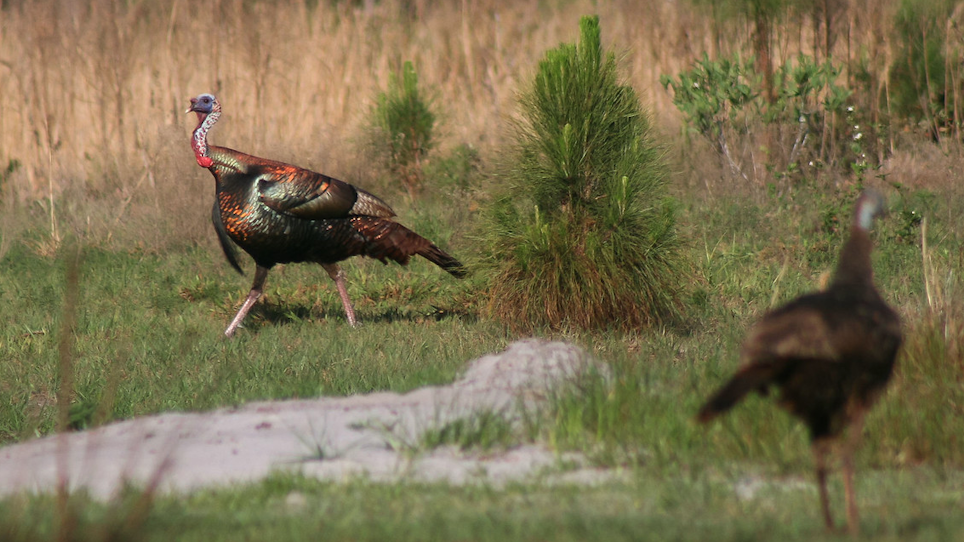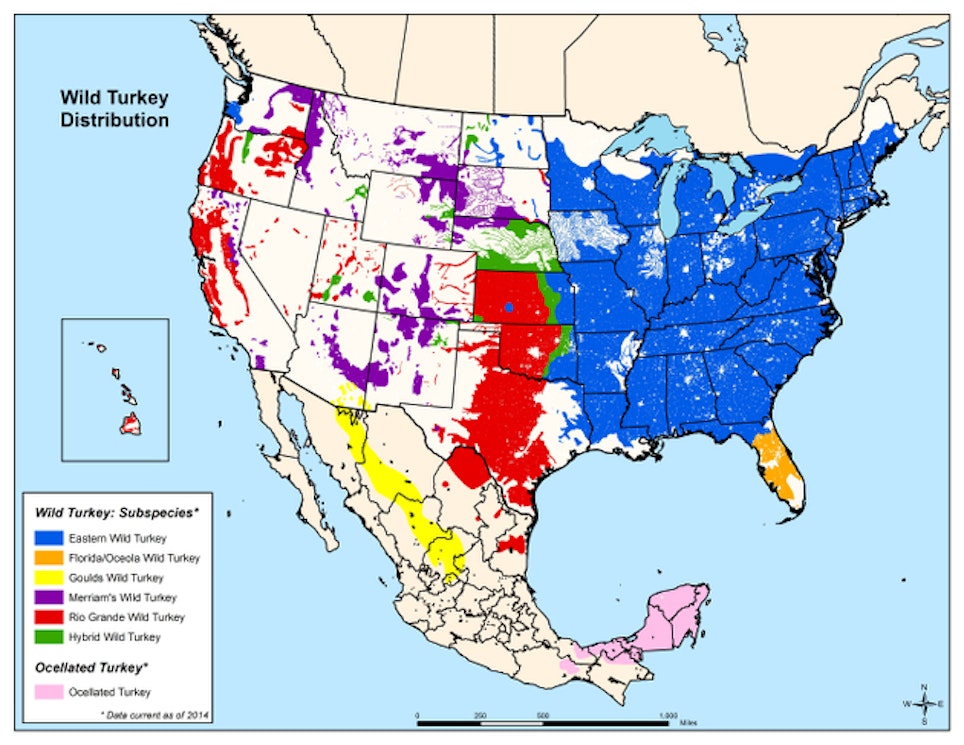In the South, the beautiful (yet stinky) Bradford pear trees are blooming white and fruit trees are beginning to show color. Some of you might have purchased a new box of Claritin or the like, while others are putting lines on spinning rods for bluegill spawning and topwater fishing.
And then there are the turkey hunters. The National Wild Turkey Federation published its 2019 Spring Hunt Guide yesterday, and that marks the eve of hunting's return. It returns for some sooner than it does for others. March marks the earliest opening dates for state's in warmer climates. But March also means the dominos are beginning to fall for everyone.
Spring hunting season is the one that puts you outside when the woods are coming alive. For some it begins with the smell of honeysuckle and ends with mosquitos buzzing around your mesh turkey mask, trying to find an opening.
So who are the lucky ones? Those who will find themselves resting against a turkey tree in a few weeks? Or, maybe your home state’s turkey season doesn’t open for a bit, but you’re looking to hit the road. It’s not too late. In March, most open hunting seasons are in regions with Eastern wild turkeys. But California is home to the Rio Grande wild turkey, and their season opens early too. In Nebraska, hunters will get into the Merriam’s subspecies. Of course, there’s also Florida’s Osceola wild turkey, likely the most sought-after March bird. Osceolas are limited to the Sunshine State, and the NWTF estimates there are about 100,000 Osceolas in the state today.
Here’s an NWTF map of the U.S. wild turkey distribution by species:
Now, here are your March opening dates for wild turkey season, courtesy of the National Wild Turkey Federation’s 2019 Spring Hunt Guide:
Alabama
Game Agency Website: https://www.outdooralabama.com/what-hunt/turkey-hunting-alabama
Agency Contact Number: (334) 242-3469
Current Population Estimate: Not provided
2018 Harvest Data: Hunters reported 9,645 spring gobblers in Game Check, Alabama’s mandatory harvest recording and reporting system. They reported 27,400 spring gobblers in a post-harvest survey conducted by Responsive Management.
Season Dates: March 16-April 30 (varies by zone and county)
Bag Limit: One gobbler per day; five during combined fall and spring seasons
Public Land Progress: Researchers in Barbour Wildlife Management Area (Barbour County in southeast Alabama) completed a habitat enhancement Super Fund project in 2018 to benefit Eastern wild turkeys. This project entailed renting a skid steer with diamond mulching head to remove mid-story trees and brush to stimulate growth of grasses and forbs improving brood-rearing habitat for wild turkeys.
Special Notes: 2018 was the second spring season of the Game Check system. Thus, the reported harvests likely under-represent the actual number of total harvested birds. Brood survey trend indicates a decline in reproduction growth. Researchers are making strides to develop a scientifically robust method for population estimates.
California
California
Game Agency Website: https://www.wildlife.ca.gov/Hunting/Upland-Game-Birds
Agency Contact Number: (888) 334-2258
Current Population Estimate: In 2004, approximately 250,000 wild turkeys were in the state. There is no current monitoring other than monitoring the North American Breeding Bird Survey trends from raw data.
2018 Harvest Data: No data for 2018; 2016 estimate was 23,503 birds (combined spring and fall)
Season Dates: General – March 30-May 5
Bag Limit: One bearded bird per day; maximum of three per season.
Public Land Progress: The California Department of Fish and Wildlife provided funds to the NWTF from its Upland Game Bird Account for two habitat improvement projects. First, the NWTF completed a project on the 21,000-acre Knoxville Wildlife Area to convert a grassland dominated by nonnatives back to native grassland, and installed two water sources. The department also funded the mastication of 50 acres of ponderosa pine as part of a 2,976-acre forest thinning project in the Eldorado National Forest. The goal is to increase diversity of shrubs, grasses and forbs, while also increasing acorn production.
Florida
Florida
Game Agency Website: https://myfwc.com/hunting/season-dates/
Agency Contact Number: (850) 488-4676
Season Dates: March 2 to April 7 south of SR 70; March 16 to April 21 north of SR 70
Bag Limit: Two birds (only one in Holmes County)
Current Population Estimate: Not provided
2017 Harvest Data: 22,307 birds
Public Land Progress: NWTF, the Florida Wildlife Commission and the Florida Forest Service have worked with the Southwest Florida Water Management District through the wild turkey cost-share program to roller-chop and burn areas of dense palmetto and shrub cover, opening the understory and improving ground cover conditions in the Green Swamp in Polk, Sumter and Lake counties in the heart of Osceola Country.
Georgia
Georgia
Game Agency Website: https://georgia.gov/blog/2018-08-17/2018-2019-hunting-seasons-summary
Agency Contact Number: (770) 761-3045
Current Population Estimate: 300,000
2018 Harvest Data: Not provided
Season Dates: March 16-17 (Youth/Mobility Impaired Only); March 23-May 15
Bag Limit: Three gobblers
Public Land Progress: The Oconee National Forest, in central Georgia, has an active timber management and prescribed burning program and has conducted brush management for forest understory restoration.
Mississippi
Game Agency Website: https://www.mdwfp.com/wildlife-hunting/turkey-program
Agency Contact Number: (601) 432-2199
Current Population Estimates: 250,000 – 300,000 birds
2018 Harvest Data: 24,763 birds
Season Dates: Youth Season - March 8-14; General season - March 15-May 1
Bag Limit: One adult gobbler with a 6-inch beard or longer per day; three per spring season. Hunters aged 15 years of age or younger may harvest one gobbler of choice (any age) per day; three per spring season.
Public Land Progress: Not provided
Special Notes: Mississippi will institute a mandatory reporting system for the first time in 2019. All hunters, regardless of license status, will be required to document their turkey harvests on a reporting record prior to moving and will have until 10 p.m. on the day of harvest to complete the reporting process and receive a confirmation number. The Mississippi Department of Wildlife, Fisheries and Parks has created a harvest reporting smartphone app that can completely cover all the hunter's reporting obligations. If not using the smartphone app, hunters can report their harvests at https://www.mdwfp.com or by calling 1-800-BE-SMART.
Nebraska
Game Agency Website: http://outdoornebraska.gov/huntingseasons/
Agency Contact Number: (402) 471-0641
Current Population Estimate: Not provided
2018 Harvest Data: 30,062 permits issued, 17,731 birds harvested; 61.3 percent hunting success rate
Season Dates: Archery - March 25 to May 31; Youth - April 6 to May 31; Shotgun - April 13 to May 31
Bag Limit: Nebraska Game and Parks allows hunters to purchase up to three permits in the spring, and each allow for the harvest of one male or female bearded turkey.
Public Land Progress: There have been several projects recently on Ponderosa Wildlife Management Area in Nebraska's Pine Ridge to benefit Merriam's subspecies. There have been several timber-thinning projects, as well as a warm season grass planting and renovation.
South Carolina
Game Agency Website: http://www.dnr.sc.gov/regs/turkeyseason.html
Agency Contact Number: (803) 734-3886
Population Estimate: 120,000 birds
2018 Harvest Data: 17,939 birds
Season Dates: Private land March 20-May 5. Public (Wildlife Management Area) land April 1-May 5
Bag Limit: Three gobblers; no more than two per day. Some WMAs are more restrictive, so check regulations at http://www.dnr.sc.gov/regs/hunting/index.html.
Public Land Progress: Annual cooperative efforts between the South Carolina Department of Natural Resources, the USDA Forest Service and NWTF South Carolina include construction of wildlife openings, planting food plots and prescribed burning in the Sumter National Forest benefiting the Eastern wild turkey.
Tennessee
Game Agency Website: https://www.tn.gov/content/tn/twra/hunting/big-game/turkey.html#springTurkeyHunt
Agency Contact Number: (615) 781-6610
Current Population Estimate: 250,000 birds
2018 Harvest Data: 28,267 birds
Season Dates: Youth – March 23-24; Regular season - March 30-May 12
Bag Limit: One bearded turkey per day, not to exceed four per season
Public Land Progress: Bridgestone Firestone Wildlife Management Area - native warm season and invasive grass management.
Texas
Game Agency Website: https://tpwd.texas.gov/regulations/outdoor-annual/regs/animals/turkey
Agency Contact Number: (512) 389-4800 or (800) 792-1112
Current Population Estimate: 500,000
2018 Harvest Data: Not provided
Season Dates: Season dates vary by county. Check local regulations for the county you plan to hunt at https://tpwd.texas.gov/regulations/outdoor-annual/regs/animal_listing.
South Zone: March 17-April 29
North Zone: March 31-May 13
Rio Grande 1 - Gobbler Zone: April 1-30
Eastern 1 - Gobbler Zone: April 15 to May 14
Bag Limit: Four turkeys, but no more than one Eastern wild turkey
Public Land Progress: James E. Daughtrey Wildlife Management Area - Tilden, Texas, Rio Grande Wild Turkey, brush management to increase brood habitat and useable space
Special Note: Most wild turkeys are located on private lands in Texas. There are a number of outfitters and private landowners who provide hunting opportunities across Texas.
If you’d like to read more the traits unique to each wild turkey subspecies, go to this fact sheet on wild turkey characteristics.







